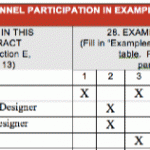Meetings have a reputation. They can be time sinks. It’s easy to walk away from one wondering what was accomplished and what, if anything, will get done.
But it doesn’t have to be that way. In fact, with one little change, you can dramatically increase the value of any meeting.
Define Next Steps The Right Way
I consider myself a sane, rational, and mild-mannered guy. The other day, I was at a golf outing when I received an email that identified these “next steps” from a recent committee meeting (with some identifying details changed).
Next steps:
- Jane Doe to continue to manage the return of assets and the technical side of the document production.
- The committee will focus on content.
- The committee to meet to confirm a work plan, schedule, provide an update on content.
After reading this, it took every ounce of self-control not to smash my club into the golf cart like a deranged lunatic.
Why That’s Not An Extreme Response
Those might seem like reasonable next steps. In fact, they might look like the next steps you see on a regular basis.
So, what am I freaking out about?
My expectation for next steps is that every one contains the following information:
- What physical action needs to be taken?
- Who has agreed to perform this action?
- What’s the deliverable?
- And when has this person agreed to deliver it by?
If next steps are not clearly, and accurately, defined…it is impossible to track whether or not they get done. That’s why I go to great lengths to identify these four things during any and every meeting.
Let’s look at the important nuances in the four elements of a legitimate and useful “next step.”
The Physical Action
One of the most important things I learned from David Allen is that actions are physical. If you can’t draw a picture of someone doing it, it’s not an action.
Let’s look at one of the “next steps” mentioned above:
“Jane Doe to continue to manage the return of assets and the technical side of the magazine production.”
Could you take out a piece of paper with some crayons and draw a picture of that? Nope.
Here’s an example of a real “next step” that was identified in that meeting:
“Jane Doe will forward Matt’s email (with directions for transferring the site) to Mr. X and find out if those steps will be taken, and if so who will be doing them. Then she’ll send an email with her findings to the committee by Tuesday.”
Sending an email is a physical action. You can draw a picture of it in your mind.
“Managing” consists of a series of actions. It’s impossible to visualize. So, how are you going to determine whether it was done or not?
You have to define the next physical action that needs to be taken.
Agreements About Who And When
If I didn’t agree (verbally or in writing) to do something for you…I’m not going to do it.
Why would I? Why would you? Why would anybody?
A huge mistake people make in meetings is assuming agreement.
Worse yet, they’ll fail to get agreement on or even discuss the delivery date for an action during the meeting. Then they’ll pull a due date out of their butt, send it off after the meeting, and wonder why “nobody ever meets their deadline.”
During the meeting, you must get a verbal agreement from the person responsible for the task. They must verbally agree to a date when they will provide the deliverable.
And if the person responsible for this task identifies a delivery date that doesn’t “feel likely” to you…it’s your responsibility to confirm their commitment.
“Bob, are you sure, based on your schedule, you can get that to us by the 30th?”
If they can commit, great. If not, ask them what a more realistic date would be. Or ask if there is something another person can do that would help them meet that original date.
All “next steps” need to confirm:
- Who agreed to take the action
- The delivery date they agreed to
If you don’t have those agreements, you can’t have confidence that the task will be done.
The Deliverable
Here’s another thing people commonly fail to do during meetings: define the deliverable.
Get specific about what the deliverable is. There’s a HUGE difference between one paragraph in Microsoft Word and a three-page PDF file.
So, what is the deliverable for this next step? What does the end result look like?
Small Change With Big Results
Remember, every “next step” you write down and distribute to a team needs to answer these four questions:
- What physical action needs to be taken?
- Who has agreed to perform this action?
- What’s the deliverable?
- And when has this person agreed to deliver it by?
If your “next steps” don’t include this information, they are worthless and a waste of time.
Yes, I said that.
But if, during the meeting, you make sure to answer these four questions for every next step…
…and you document them in a post-meeting follow up…
…you’ll find meetings suddenly become much more effective.
Now It’s Your Turn
What steps do you take to ensure that meetings are productive? Share your tips and advice in the comments.





I start marketing meetings with the status of the action items from the last meeting. Granted there is a bit of “name and shame” involved which sometimes doesn’t feel good, but I think it helps move things forward.
Lynda,
Thank you for contributing to the conversation.